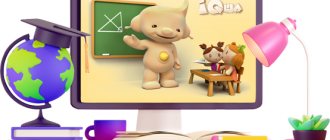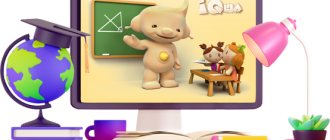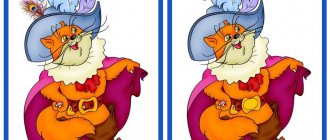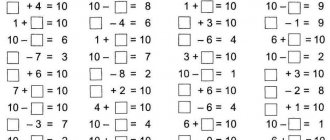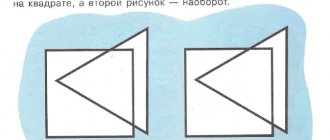In order for a 6-year-old child to develop himself in the field of mathematics, it is necessary to correctly prepare the task for him. Here it would be good to know the child’s temperament and feel his character. You should also be prepared for the fact that you need to start teaching your child from the very basics. It is advisable that a 6-year-old child has already learned to count to 20. And can solve simple mathematical problems with numbers up to 10. The child also needs to develop an understanding of the calculations “addition”, “subtraction”, “more-less-equal”. By age 7, children can already count and compare tens. You can test your child’s knowledge and expand his mathematical knowledge at home; here are examples of tasks in pictures for 6-year-old children in mathematics.
Learning to count
Exact counting: for the child, how many footballs, basketballs, handballs, and tennis balls are there in the picture. And if your son or daughter doesn’t know a certain sport, be sure to tell them and find pictures on this topic. Expand your horizons.
Counting to 20: count from 1 to 20. Say each number out loud and point with your finger to find out where the magic path leads. Look, what number comes after 12? Which one precedes 17? What numbers are between 13 and 16, 17 and 19?
Explain that a number, when written, can have one digit (single digit number) or two digits (double digit number). To learn how to count quickly, you need to learn the names of numbers from 1 to 20 and the names of tens. And in the future, simply add to the tens the numbers already familiar to you from 1 to 9.
It is important, when teaching a child to count to 30 and beyond, to pay attention and correctly name the previous and subsequent numbers in a series.
Counting to 30: count, moving your finger, from 1 to 30. Look, what number comes after 20? What number comes before 28?
Learning tens: when there are few objects, we can count them one by one 1-10. But if there are a lot of objects, it is more convenient to count by tens, which means combining them into groups of 10. If there are 10 apples in a pile, that’s 1 dozen, and if there are 2 times 10 apples, that is, 20 apples are 2 dozen.
Studying the basics of mathematics with children aged 6-7 years is a continuation of a series of lessons on introducing the elements of mathematics, begun at the age of 3-5 years.
Previously, the kids learned about what shapes, shapes, sizes there are, became acquainted with the concepts of more and less, etc.
At the age of six, classes to become familiar with the elements of mathematics become more complex, new meanings and symbols appear. For example, what is an angle, what angles are there; what is a line, a closed line; what is a plane, a point.
Children become familiar with numbers, learn to count to 10 and back; learn to solve logical problems.
Some primary school teachers are against teaching mathematics to preschoolers. But at the same time, when choosing first-graders, they prefer to take prepared children, rather than those who are not familiar with elementary mathematics.
Therefore, I recommend that parents be sure to prepare their children for school by giving them knowledge in other sciences.
What a preschooler should know by age 7
- What is a line, what types of lines are there (straight, curved, horizontal, vertical, oblique); line segment;
- what does a closed curve mean?
- be able to use a ruler;
- the concept of a point (one, many, drawing a line through one point, through two points);
- know the calendar, navigate time, the seasons, the sequence of months, their names;
- know what an angle is, the differences (right angle, acute, obtuse, unfolded);
- what does plane mean, to be able to navigate on a plane.
At this age, previously acquired knowledge about triangles (of which there are), rectangles, polygons, squares, circles, and ovals is consolidated.
Much attention is paid to counting within 10 - up and back. The child must navigate neighboring numbers and divide them into sets.
To strengthen fine motor skills of the fingers, it is necessary to offer a 6-year-old child various shading or drawing of objects followed by shading.
After reading the list of necessary knowledge, you can say that your son or daughter will learn all this at school and there is no need to burden them now.
Yes, they will be introduced to these concepts at school, but there the lessons will move quickly, without stopping for individual work. Your child may not understand something and ignorance will lead to problems in the future.
How to work with a preschooler
6 years is a great age to learn mathematics. The preschooler learned to speak well, reason and even think logically.
Give him logic problems more often.
For example, how many tails do two cats have?
How many wheels does the car have?
How many paws do two dogs have?
You can come up with a lot of such riddles.
To develop logical thinking, it is important to teach a child to play chess and checkers.
All activities with preschool children should be conducted in the form of games.
Math games
"Building a TV tower"
We take the cubes and place them on top of each other. It turns out to be a tower.
We show one side (the edge of the tower), explain that this is a vertical line. (Show how it is located on the sheet).
If we take bricks from a building set and place them on the table one after another, we will get a line, it will have a horizontal line compared to the tower.
To consolidate, ask your child what he sees around him vertically (tree trunk, house, electrical pole) and horizontally (electrical wires, path).
By building steps from cubes, we get an inclined line. Suggest drawing a winter slide using a slanted line.
To get acquainted with the plane and the ability to navigate on it, “Graphic dictations” suited .
On a sheet of squared paper (preferably large) you put a dot (to introduce the concept of a dot). From there, the child must draw a line in the direction that you indicate to him. For example, draw a line 2 cells to the left, then 3 cells up (down, right, etc.).
If you prepare in advance for the dictation, you can come up with a figure that you can then shade.
Example of drawing a key
We retreat a few cells from the edge and put a point. We dictate the following: count 8 cells to the right, draw a line. count 2 cells up, then 4 to the right, 5 down, 4 left, 2 up, 4 left, 3 down, 1 left, 1 up, 1 left, 1 down, 1 left, 3 up, 1 left, connect to the point.
Learning numbers using a calendar
Studying the calendar, months, and seasons is best done with a tear-off calendar. Show every day what day it is, what month, what year. Ask what date it was yesterday, what day of the week it was yesterday and today.
If some holiday is expected ahead, you can suggest counting the days how many are left until this holiday. And, of course, walking outside, observing nature, marking the time of year, temperature, and precipitation on the calendar are mandatory.
All games for introducing mathematics should be in the form of a game, interesting and educational. For games you can use Dienesh blocks, Cuisenaire sticks, numerous puzzles, such as Columbus's egg; math puzzles.
By studying the basics of mathematics with children 6-7 years old, parents will be sure that their child will be properly prepared for school and future classes there will not become a serious test for him.
Solving problems and examples
simple examples of addition in pictures
If your 6-year-old child copes with these tasks easily, gradually make the tasks more difficult. Try subtracting.
Examples in mathematics for children 6 years old
We learn to create examples of addition and subtraction and develop logical thinking and graphic skills. Example cards can be printed.
Quests for smart people
Solve the examples, see where the boy Petya made a mistake, find the wrong answers
The first tasks for those children who have never encountered mathematical problems before in their lives must be given gradually. If your baby doesn’t even know numbers, start classes with tasks for children 3-5 years old. And you need to start with the most basic examples. This can be addition and subtraction within 5. Counting sticks are perfect for this purpose. It is necessary to present the principle of addition and subtraction in such a way that he can understand the basic essence of any mathematical operations.
However, before this, it is very important to teach your child to count to at least 10. If he has not mastered this yet, then it is too early to prepare any math assignments for him. In order for children to learn to count well, as well as subtract and add, you can prepare thematic posters that colorfully depict any objects that are close to their perception. For boys, such objects can be cars, toy soldiers, airplanes, for girls - dolls, elements from dishes, dolls or other things that they often play with.
Tasks for children whose age does not exceed 6 years must be constructed very carefully. Here, in addition to studying mathematical fundamentals, a playful form of mastering the material should also be traced. After all, if mathematics tasks are selected for them in a dry and uninteresting manner, it will be very difficult for young children, given their restlessness, to master the necessary information.
A creative approach from adults when composing mathematical problems for the youngest members of the family can be pictures that depict their children’s favorite cartoon characters. This is how you can interest a child in a math lesson and create an additional incentive for him to comprehend the basics of addition or subtraction. For example, if the picture shows the famous cartoon characters Chip and Dale. And so, through a poster, they set a task for the children: how much will it add up 2 apples that Chip has with 3 apples that Dale has? And children begin to think about how to help their favorite characters resolve their dilemma.
Of course, in order to correctly create a task for children aged 6 years, you need to have not only ingenuity, but also be creative in this matter. But we should not forget that teaching the basics of mathematics to a child is not an easy task, requiring considerable diligence and patience from an adult!
How to conduct classes with a child 6-7 years old
A child in preschool age has great developmental potential and cognitive abilities. Parents simply need to help their child realize his potential. The time spent will definitely pay off. Help from parents can make future schooling enjoyable. And the adults themselves will not be upset about their child’s academic performance.
Activities with preschoolers
Here are a few tips for getting the most out of your workouts:
- Classes shouldn't be boring.
The best motivation for learning is interest. It turns children into creative individuals and provides an opportunity to feel satisfaction from their activities.
- Exercises must be repeated constantly.
Improvement in mental abilities is tested with time and duration of practice. If you cannot complete the exercise, you need to take a break and return to it later. A less complex or equal version of the task will also solve the problem.
- Be patient and take your time. It is unacceptable to offer a child tasks that exceed his real capabilities.
- Insufficient progress in classes, according to adults, should not cause anxiety in parents.
- The duration of lessons should be moderate, exceeding is unacceptable.
Diagnostics of the thinking of preschool children
If a child has lost attention due to fatigue, it is recommended to occupy him with other activities. It is necessary to determine the degree of endurance of the baby in order to slightly increase the duration of the lesson each time.
- The game form of learning is best suited for preschoolers.
- It is extremely important to regularly support the child and praise him for his perseverance and efforts. It is not recommended to compare a preschooler with other children. This helps build self-confidence.
On a note! Working with a child is joy and pleasure, not hard work. This is the best opportunity to establish friendships with your child.
